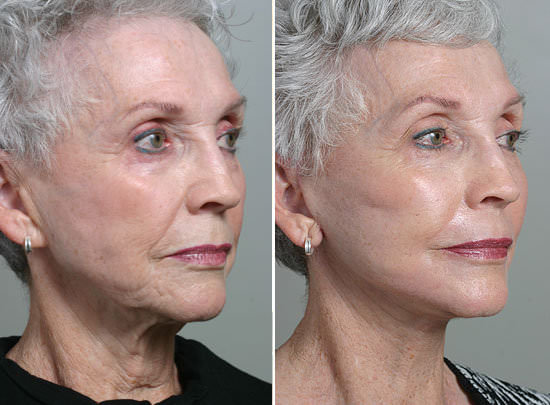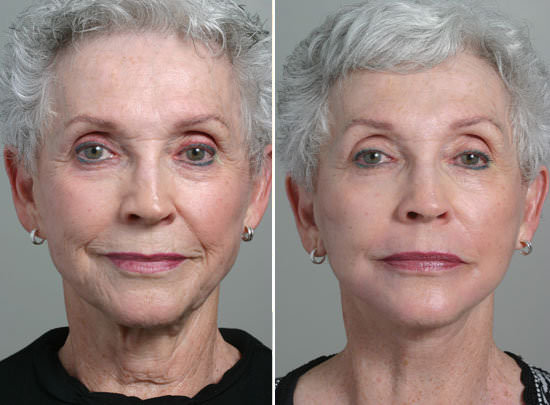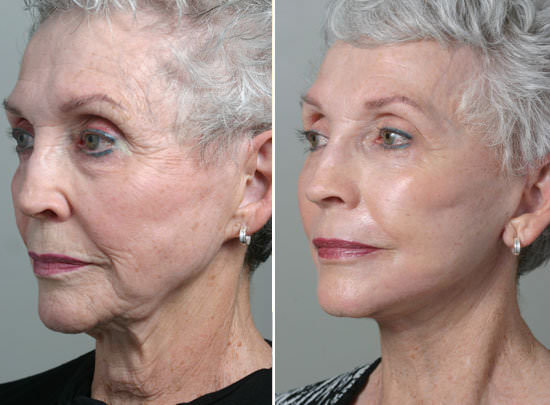


Facelift 19
The patient is a 76 year old woman noted some relapse of drooping recently after having had a face lift 25 years ago. She also wanted to improve on the scars she could feel from her previous cosmetic surgery and wanted to have the drooping cheek lifted because that was not done with her last facial cosmetic surgery. The patient also noted some wrinkles about the mouth that made her feel old and she wanted those treated as well. Her facial plastic surgery plan included a secondary facelift with a neck lift and laser treatment for wrinkles around the mouth. She was very gratified with the results of her cosmetic plastic surgery and felt that she appeared natural.
Face lifts, brow lifts and neck lifts are all lifting procedures that can have significant effect in improving laxity, cheek and jowl descent and folding/wrinkles of the overlying skin. They all achieve significant change but don’t change the character of the face and so appear natural and give even and complete results. These results are long lasting but some relapse, especially in the jowl region can occur over the long term.
Secondary Face Lift
Some patients may opt to improve on what has been lost since the last procedure and have what is referred to as a secondary facelift. The basic goals are the same as the first face lift but there are a few new secondary goals. Basic goals include lifting the jowl and creating a smooth jaw line. Regarding the original neck lift surgery, some patients may have had limited or no attention directed to the platysma, or neck muscles that shape and support the neck skin. They may have had limited or no fat removal or certain fat compartments may have changed. The original surgery may haev not included tightening of neck skin because at that time there was only facial laity and not neck laxity. In all of these cases the secondary neck lift can address what has changed over time or needs further improvement to achieve a smooth neck line and a right angle where the horizontal jaw line meets the vertical neck.
Secondary Cheek Surgery
During a first time, or primary face lift, the facial plastic surgeon may not have needed to raise the cheek because the cheek was not drooping at the time and so attention was directed to the jowl and neck. As the patient then ages, the cheek can begin to fall and this lower cheek can be addressed at a secondary facelift. When the cheek falls, a deep fold forms a the lower edge of the cheek at the junction of the cheek and the mouth. This fold starts at the corner of the nose and continues toward and ends at the corner of the mouth and is therefore called the naso-labial fold. This fold can become quite deep with time and many patients who have facial laxity use fillers to soften and sometimes eliminate this fold. In a secondary face lift when the cheek is elevated, the fold becomes softened and can, in some patients become completely flattened. One can see in these facelift surgery before and after photos that , in fact, the patient’s nasolabial fold have become flatter and softer and blend in with her other facial features.
Scar Improvement
Some patients that have had a first facelift may or may not notice that there is visible scarring about the ears. These scars may not be that apparent but can likely be improved with a secondary face lift. Some face surgeons of the past may have closed the skin under significant enough tension to cause some scarring. With another facelift, the old scar can be removed and the skin can be released further and advanced or the direction of the skin can be changed to lessen tension and the new skin closure can be closed loosely, helping to prevent scarring. Some patients may have had a first facelift incision placed in front of the ear and completely exposed where it can be easily seen by others. This exposed scar can be converted to an incision inside the ear canal with a secondary face lift.
Attention to detail with a secondary face lift can not only help patients get back what they have lost but make additional improvements.
